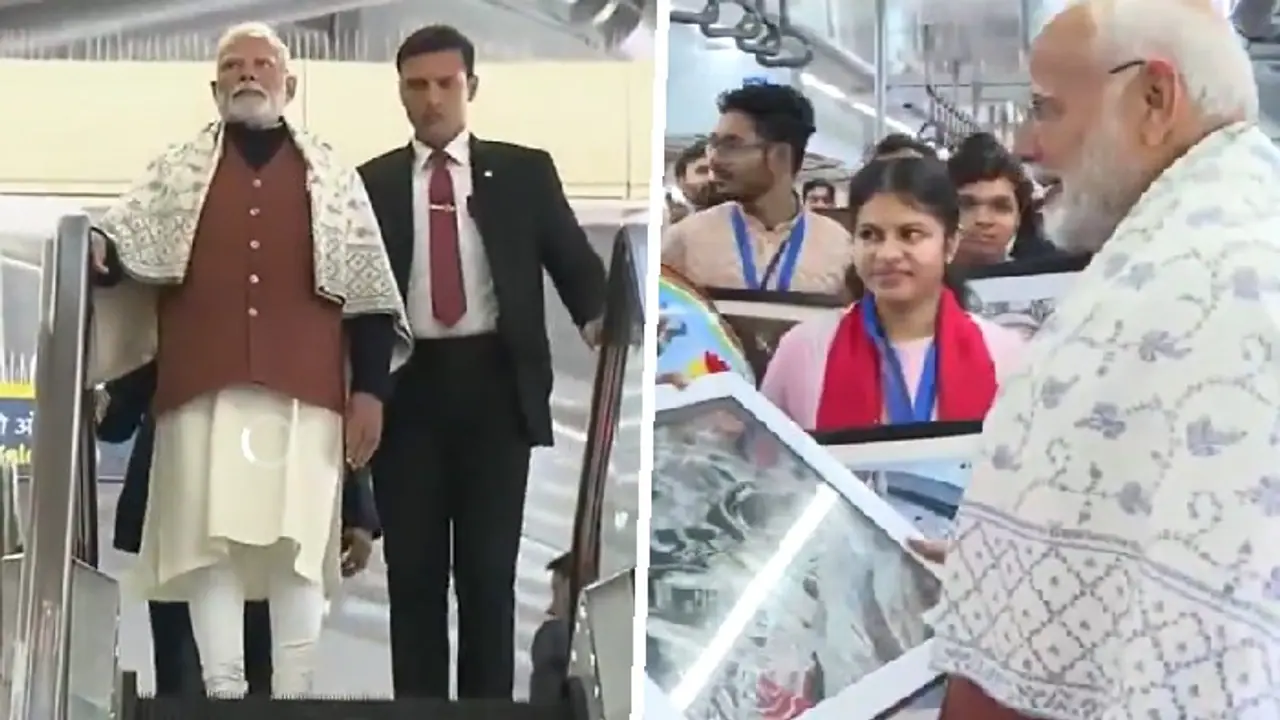India has officially achieved a monumental milestone in urban transportation, with its metro rail network now spanning over 1,000 kilometers, making it the third-largest metro network in the world.
India has officially achieved a monumental milestone in urban transportation, with its metro rail network now spanning over 1,000 kilometers, making it the third-largest metro network in the world. This achievement comes after China and the United States, cementing India’s position as a leader in expanding urban mass transit.

Prime Minister Narendra Modi inaugurated the extension of Delhi Metro’s Magenta Line and a new 13 km section of the Delhi-Ghaziabad-Meerut Namo Bharat Corridor on Sunday. Following the inauguration, PM Modi traveled between Sahibabad in Uttar Pradesh and New Ashok Nagar in Delhi. Passenger services will begin at 5 pm, with trains operating at a frequency of 15 minutes.
The Namo Bharat corridor's newly inaugurated 13 km section includes a six-kilometer underground stretch, marking a significant leap in metro operations. Notably, the Anand Vihar station, one of the largest on the corridor, will serve as a key interchange. From Anand Vihar, commuters can reach Meerut South in just 35 minutes. The newly launched section is expected to further ease congestion and improve connectivity between Delhi and Uttar Pradesh.
In a post on social media, Prime Minister Modi highlighted the extensive work done to boost metro connectivity over the past decade, emphasizing its role in improving "Ease of Living" for citizens. "Over the last decade, extensive work has been done in boosting metro connectivity, thus strengthening urban transport and enhancing ‘Ease of Living’," the Prime Minister wrote.
India’s metro network has seen tremendous growth over the last decade. The number of states with metro services has expanded from five to 11, while the number of cities benefiting from metro connectivity has grown from five to 23. Passenger numbers have risen dramatically, with daily ridership increasing from 28 lakh in 2014 to over one crore today—a 2.5 times increase. Additionally, the total distance traveled by metro trains has tripled, growing from 86,000 kilometers to an impressive 2.75 lakh kilometers.

India's Metro Network: A leap towards transforming urban mobility
Under the leadership of Prime Minister Narendra Modi, India has embarked on an ambitious metro rail revolution that is reshaping the way people move across the country. From underwater marvels to driverless trains, India's metro system is rapidly becoming a symbol of efficient, eco-friendly, and fast urban mobility.
India's metro network has now reached a significant milestone, with 1,000 kilometers of metro rail lines in operation, making it the third-largest metro network globally. Moreover, projects spanning over 998 kilometers are currently underway, further transforming the nation's urban landscape. The expansion of metro services is happening at an unprecedented pace, with an average construction rate of 6 kilometers per month.
Record-Breaking Growth in Metro Ridership
India’s metro systems are bustling with activity. With daily ridership now exceeding 1 crore passengers, metros have become the preferred mode of transportation for millions of commuters. As metro services expand to new cities and regions, they are not only easing urban congestion but also contributing to environmental sustainability by promoting eco-friendly modes of travel.
Unprecedented Speed in Construction
The speed at which India is building its metro network is unparalleled. On average, 6 kilometers of metro track is being constructed every month, a testament to the nation's commitment to reshaping urban mobility. This fast-paced growth is transforming how people navigate cities, with metro lines rapidly connecting previously distant areas and reducing travel time significantly.
India’s Homegrown Metro Solutions
India’s metro revolution is increasingly driven by domestic innovation. Over 1,000 metro coaches have been produced in just five years, and a majority of the civil structures supporting the metro systems have been built locally. Additionally, India is making its mark globally with the delivery of the first "Make in India" driverless metro train set.
India’s Metro Systems Go Global
The success of India’s metro projects extends beyond its borders. Delhi Metro, one of the country’s most advanced urban transit systems, is currently building a metro rail network in Bangladesh. India has also provided consultancy services for Jakarta’s metro system and is exporting metro coaches to Canada and Australia, marking a significant expansion of India's metro expertise.
Rising to the Top of Global Rankings
India’s metro systems are rapidly advancing on the global stage. In 2022, India surpassed Japan in terms of metro rail projects, and it now ranks as the third-largest metro network in the world. With ongoing projects and future expansions, India is on track to become the second-largest metro network globally, further strengthening its position as a leader in urban mobility.
A Marvel of Engineering: Kolkata’s Underwater Metro
India has also made history with the launch of its first underwater metro in Kolkata. This engineering feat, which has captured international attention, represents a new era in public transportation. Prime Minister Narendra Modi himself rode on this historic route, marking it as a milestone in India’s metro journey.
